Beer and electricity had a common admirer…
October 11, 2021 by Laura Heilenman · Leave a Comment
 All of the Founders are worthy of a great deal of respect however, some grab your attention more than others. From George Washington’s noble bearing to Jefferson’s nation building writing. I would argue none capture the imagination more than Benjamin Franklin. Larger than life, with his bifocals and kite in a lightning storm, he makes a great historical figure for kids to study while inspiring adults with his witty wisdom such as, “Beer is proof that God loves us and wants us to be happy.”
All of the Founders are worthy of a great deal of respect however, some grab your attention more than others. From George Washington’s noble bearing to Jefferson’s nation building writing. I would argue none capture the imagination more than Benjamin Franklin. Larger than life, with his bifocals and kite in a lightning storm, he makes a great historical figure for kids to study while inspiring adults with his witty wisdom such as, “Beer is proof that God loves us and wants us to be happy.”
Among the many issues we have at Rare Newspapers covering Franklin is one which is described as follows:
”The earliest account of the electrical experiments made by Benjamin Franklin, at Philadelphia (where he was then the post-master) appeared anonymously in ‘The Gentleman’s Magazine for January, 1750‘.”
This article mentions several of Franklin’s important discoveries, including: “…that it will live in water…that it is more strongly attracted by slender sharp points than by solid blunt bodies…that bodies replete with this fire strongly attract such as have less of it, and repel such as have an equal quantity…”.
Beer, electricity, bifocals and chess – take a look at this brilliant, yet quirky Founder with new eyes by reading about him in the papers of his day.
The Traveler… early Sodoku?…
July 2, 2018 by The Traveler · Leave a Comment
 Today’s journey took me to London, England, by the means of The Gentleman’s Magazine of July, 1768. I found an interesting plate entitled “A Magic Square of Squares” with an accompanying article “Surprising Properties of Numbers placed in Dr. Franklin’s Magic Square of Squares”. This is an interesting puzzle by Benjamin Franklin. “The great square is divided into 256 small squares, in which all the numbers from 1 to 256 are placed in 16 columns, which may be taken either horizontally or vertically. The properties are as follows: 1. The sum of the 16 numbers in each column vertical or horizontal, is 2056. 2. Every half column, vertical and horizontal, makes 1028, or half 2056. 3 Half a diagonal ascending, added to half a diagonal descending, makes 2056; taking these half diagonals from the ends of any side of the square to the middle thereof, and so reckoning them either upward or downward; or sidewise from left to right hand, or from right to left…”
Today’s journey took me to London, England, by the means of The Gentleman’s Magazine of July, 1768. I found an interesting plate entitled “A Magic Square of Squares” with an accompanying article “Surprising Properties of Numbers placed in Dr. Franklin’s Magic Square of Squares”. This is an interesting puzzle by Benjamin Franklin. “The great square is divided into 256 small squares, in which all the numbers from 1 to 256 are placed in 16 columns, which may be taken either horizontally or vertically. The properties are as follows: 1. The sum of the 16 numbers in each column vertical or horizontal, is 2056. 2. Every half column, vertical and horizontal, makes 1028, or half 2056. 3 Half a diagonal ascending, added to half a diagonal descending, makes 2056; taking these half diagonals from the ends of any side of the square to the middle thereof, and so reckoning them either upward or downward; or sidewise from left to right hand, or from right to left…”
The information continues with this sounding like a very early Sodoku puzzle!
~The Traveler
Where did it end up? Boston
October 20, 2016 by GuyHeilenman · Leave a Comment
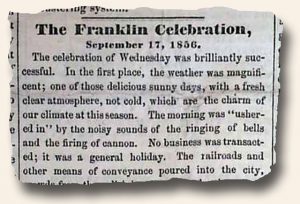 As both collectors and sellers of historic newspapers, we (Rare Newspapers) often wonder what happens with many of the issues which pass through our hands. We know some have been given to Presidents, well-known authors, and various public figures throughout the world. Equally rewarding are those which end up in the hands of those whom either love history or have a personal connection with the issue’s content. Many are found in museums for all to see, yet others a likely stored away in boxes for protection and many never again see the light of day. Regardless of their final resting place, we derive a certain degree of satisfaction in knowing we play a part in preserving history in written form. With these thoughts as a backdrop…
As both collectors and sellers of historic newspapers, we (Rare Newspapers) often wonder what happens with many of the issues which pass through our hands. We know some have been given to Presidents, well-known authors, and various public figures throughout the world. Equally rewarding are those which end up in the hands of those whom either love history or have a personal connection with the issue’s content. Many are found in museums for all to see, yet others a likely stored away in boxes for protection and many never again see the light of day. Regardless of their final resting place, we derive a certain degree of satisfaction in knowing we play a part in preserving history in written form. With these thoughts as a backdrop…
We recently became aware of how one issue has been put to use (see image). Feel free to explore:
BOSTON SEMI-WEEKLY ADVERTISER, Sept. 20, 1856
Pennsylvania’s first newspapers…
December 12, 2011 by TimHughes · Leave a Comment
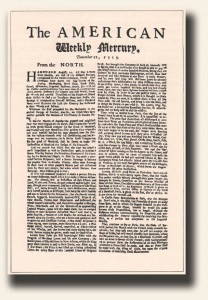 It was only in Boston where a newspaper came off a printing press prior to any in Pennsylvania. It was 15 years after the “Boston News-Letter” of 1704 (not counting the one-issue run of Boston’s “Publick Occurrences Both Foreign & Domestick” in 1690) when, on December 22, 1719, Andrew Bradford began his “American Weekly Mercury” (see image) in Philadelphia, Pennsylvania’s first newspaper. This weekly would last until 1746.
It was only in Boston where a newspaper came off a printing press prior to any in Pennsylvania. It was 15 years after the “Boston News-Letter” of 1704 (not counting the one-issue run of Boston’s “Publick Occurrences Both Foreign & Domestick” in 1690) when, on December 22, 1719, Andrew Bradford began his “American Weekly Mercury” (see image) in Philadelphia, Pennsylvania’s first newspaper. This weekly would last until 1746.
But certainly the most successful newspaper in the colony, if not in all of colonial America, was the “Pennsylvania Gazette” begun in December, 1728 by Samuel Keimer. Within a year it was purchased by Benjamin Franklin. As Oswald notes: “…Under Franklin’s guidance, there appeared for the first time a colonial newspaper produced by a man of education who was in addition a capable printer, a versatile writer, and energetic news gatherer and an enterprising & resourceful businessman. This combination had the inevitable result of placing the “Pennsylvania Gazette” in the lead, and it thereby established a model for others to follow.” The “Gazette” would make Franklin a wealthy man and his name appeared on the imprint through 1765.
Pennsylvania has the distinction of having America’s first daily newspaper, the “Pennsylvania Evening Post & Daily Advertiser“, which started publication in 1775 as a tri-weekly and became a daily on May 30, 1783.
Few things change in politics…
September 24, 2011 by TimHughes · Leave a Comment
It’s interesting how, in some aspects of life, few things change over hundreds of years. Complaints about politicians not focusing on substantive issues was a problem back in 1790, in just the second year of the American federal government, as this article from the July 3, 1790 “Pennsylvania Packet“ of Philadelphia, clearly shows…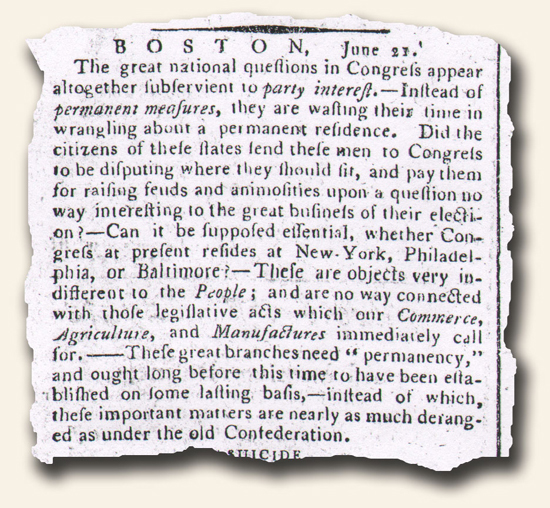
A real gem…
September 16, 2010 by GuyHeilenman · Leave a Comment
In the past we’ve taken several looks at one of the inherent pleasures of the rare newspaper collecting hobby – that of finding hidden (unexpected) gems within issues. While unearthing such gems is nearly a daily occurrence for our staff, it is especially rewarding when we discover content of the significance as what we’ve shown below. The December, 1787 issue of The American Museum contains, in addition to the printing of four Federalist Papers and the ratification of the Constitution by Pennsylvania and Delaware, the full text of Benjamin Franklin’s final speech before the assembly on the last day of the Constitutional Convention. Thanks to one of our members, this treasure is no longer “lost”. As for the content… it speaks for itself. Please enjoy the wisdom of Dr. Franklin: 
Ben Franklin displays his wit…
August 14, 2010 by TimHughes · Leave a Comment
The December 11, 1775 issue of the “Hampshire Chronicle” from Southampton, England, includes a witty note from Ben Franklin to a friend in London, which appeared in several newspapers of the day. By his mind, the Revolutionary War was not going to be won by England through attrition.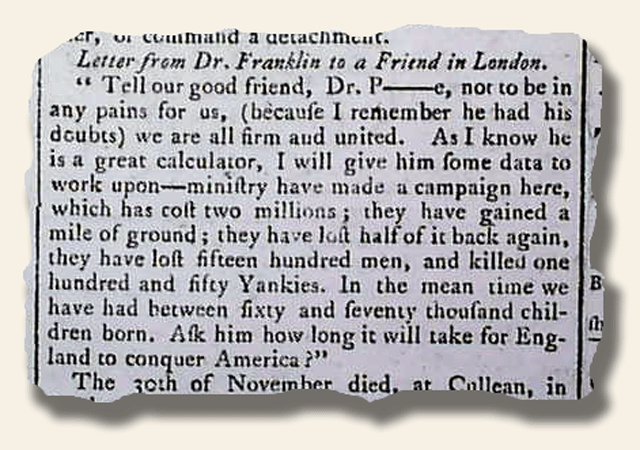
Recommended reading…
June 26, 2010 by GuyHeilenman · Leave a Comment
 Jim Wheeler, one of our “rare newspaper” friends, recently sent us an e-mail with the following recommendation for our summer reading list:
Jim Wheeler, one of our “rare newspaper” friends, recently sent us an e-mail with the following recommendation for our summer reading list:
The Constitutional Convention: A Narrative History from the Notes of James Madison, by Edward J. Larson & Michael P. Winship, ISBN 0-8129-7517
This book essentially condenses and annotates Madison’s notes taken throughout the Convention so that the language and the important concepts that were discussed can be understood today. The book includes a list of those attending the convention and their respective states. When you keep a 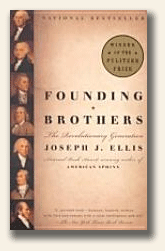 copy of this list handy while reading the notes, you can get a clear picture of the regional motives behind the discussion as the constitution was developed. This book, in conjunction with The Founding Brothers, John Ellis, were both extremely helpful in developing a working understanding of what I consider to be one of the most interesting 10 to 20 year time period in US history.
copy of this list handy while reading the notes, you can get a clear picture of the regional motives behind the discussion as the constitution was developed. This book, in conjunction with The Founding Brothers, John Ellis, were both extremely helpful in developing a working understanding of what I consider to be one of the most interesting 10 to 20 year time period in US history.
I thought that in addition to all of your other reading, these two items may be interesting and helpful.
Thanks for your suggestions Jim. To the readers of this post: “If you have a chance to read either of these (or have already done so), the community would love to hear your reactions as well.
Early printing in the New World…
September 10, 2009 by TimHughes · Leave a Comment
Another book I find very useful, although out of print, is “Printing In The Americas” by John Clyde Oswald, 1937. From time to time I will print excerpts from it which hopefully will be of interest to collectors, including the following which touches upon the very earliest years of printing in the “new world”.
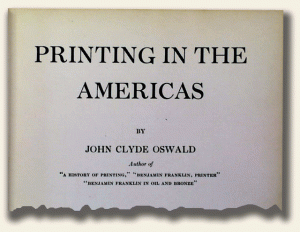 “Printing in the English colonies began during the first half of the 17th century, at which time the art was at a low ebb in Europe, and it is therefore not surprising that the printers who came to the western shore of the Atlantic Ocean were not of outstanding ability; they were but representative of the class from which they sprang.
“Printing in the English colonies began during the first half of the 17th century, at which time the art was at a low ebb in Europe, and it is therefore not surprising that the printers who came to the western shore of the Atlantic Ocean were not of outstanding ability; they were but representative of the class from which they sprang.
The first person to print in what is now the United States was a boy 18 years of age, upon whose immature shoulders had unexpectedly been thrown a heavy burden of responsibility. This boy, Matthew Daye (later in life he dropped the final ‘e’), began to print in a newly built house on the bleak shore of New England, on the edge of the forbidding wilderness that surrounded it on all sides but that which faced the sea. The year was 1638, just 18 years after the Pilgrims landed.
A new nation was in the making, in which life eventually came to embrace everything worth while, but in which in the beginning, as was to be expected, artistic accomplishment & progress were almost wholly absent. The settlers were too much occupied with the immediate necessity of clearing away the forests, harnessing the water power, building homes, founding towns and setting up local governments, to be able to find time to devote to the refinements of daily living. The primal wants had first to be satisfied. Then came the Revolutionary War, with its strain upon their resources, and later the need of facing and solving the world problems that accompanied the birth of the new nation.
The scarcity of great printers in Europe during the 17th century is to be ascribed to the fact that printing, controlled by Church and State, had ceased to be a means of art expression and had become merely a vehicle for the transmission of information (and misinformation). In England the number of printers and type founders was limited, and they were licensed and operated under strict surveillance. Restrictive measures of a somewhat similar nature were enforced in other countries.
The ruling powers endeavored to stretch a restraining army across the Atlantic to the colonies newly planted there, and they were at first partly successful because they were represented by governors subservient to their whims. the oft-quoted remark of Sir William Berkeley, governor of Virginia, will be recalled:
But, I thank God, there are no free schools nor printing, and I hope we shall not have these hundreds years; for learning has brought disobedience, and heresy, and sects into the world, and printing has divulged them, and libels against the best government. God keep us from both.”
King James II, on ascending the English throne in 1685, sent this instruction to Governor Dongan, in New York:
“And for as much as great inconvenience may arise by the liberty of printing within our province of New York; you are to provide by all necessary Orders that noe person keep any press for printing, nor that any book pamphlet or other matters whatsoever bee printed without your special leave & license first obtained.”
For 40 years thereafter this paragraph appeared in the instructions to colonial governors. Great was the respect paid by the common people of Europe to constituted authority. The bowed head and bended knee were therefore attitude familiar to the colonists; but contact with this constituted authority came to them only through the local governors and their minions, and often the closeness of the contact disclosed the fact that the supposed gods were in reality made of clay. Respect, reverence even, might for a time be publicly shown for a governor in gold lace, who proved on acquaintance to be vain, shallow, and incompetent, but it could not be privately felt, and under such circumstances the public showing was certain in time to come to an end.”


